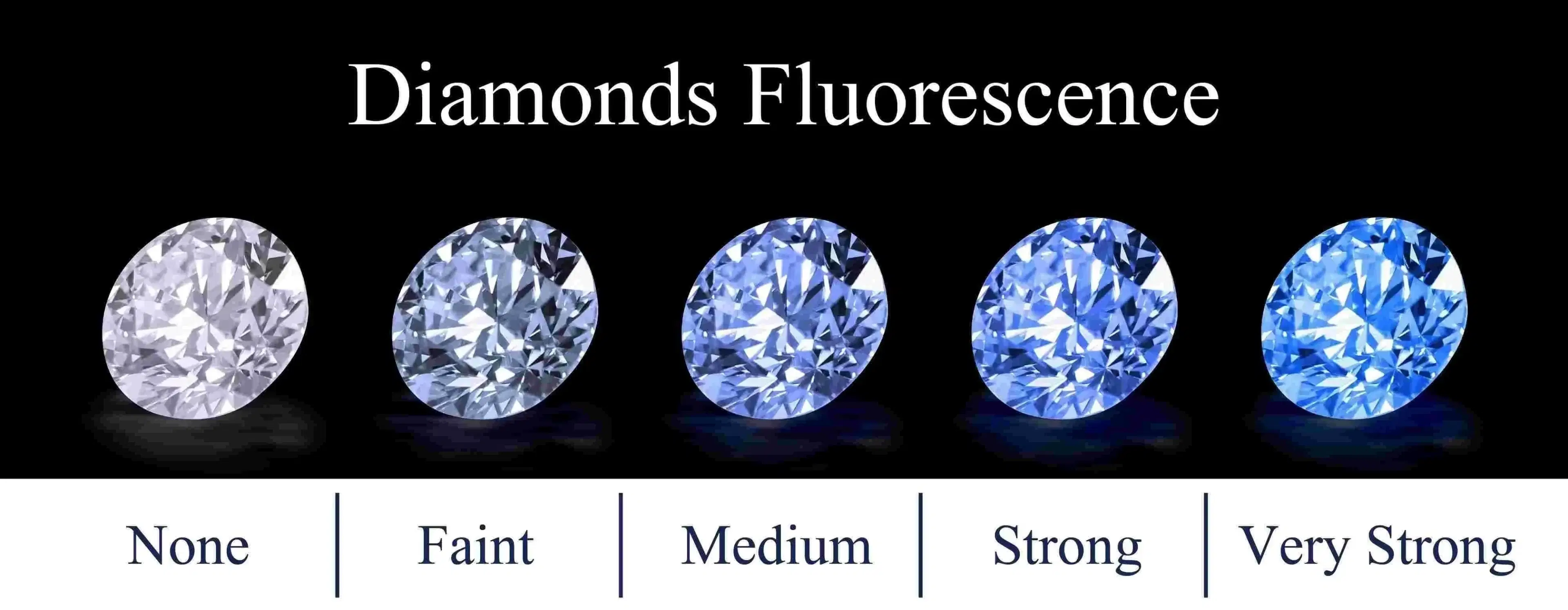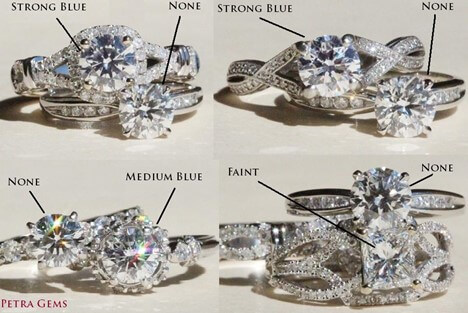What would be my best choice if I could pick between no or faint/medium blue fluorescence?
Generally, no fluorescence is preferred. However, blue fluorescence is helpful and recommended in H, I, and lower-color diamonds. If you can, avoid it in D to G color diamonds. Faint fluorescence is also acceptable for G color.
Why is fluorescence perceived negatively?
Because it is not a black-and-white topic such as carat weight or color, buyers need clarity about how to go about fluorescence. Hence, they generally try to be on the safe side and assume the worst.
What about fluorescence in D to F color diamonds, and why should it be avoided in such a range?
In most cases, fluorescence in D to F color diamonds does not negatively impact the stone. However, it can make the diamond look bluish in very few cases, so most people prefer to avoid it. Some prefer the bluish hue of white diamonds, so that might be your preference.
Is strong blue fluorescence bad?
You could get fortunate with strong blue fluorescence. People assume it is a super negative factor and avoid it, but it is not bad in H and lower color grade diamonds. It can help them look much whiter than their color since blue complements yellow. However, it can be somewhat negative in D to G color diamonds. Therefore, make sure you see the diamond in person to determine how the fluorescence affects it or have a solid return policy if you buy a D to G color diamond with strong or very strong blue fluorescence.
Do all diamonds fluoresce?
No! When GIA analyzed about 26,000 diamonds, only 25-35% exhibited some level of fluorescence.
Can fluorescence be seen with the naked eye or in any lighting?
You might see fluorescence under bright sunlight or in places with strong UV rays, such as a tanning bed. Once the source of UV rays is removed, you cannot see the fluorescence.
Can fluorescence be easily identified and detected?
No, it is tough for trained gemologists to see it. Most gemologists use high-tech tools to determine a diamond's degree of fluorescence.
Why is fluorescence not a grading factor like the 4Cs?
While GIA considers fluorescence an identifying characteristic in a diamond, we believe it is a significant price and quality factor. It can be helpful in certain diamonds but is generally a slight negative factor in colorless ones.
Is fluorescence only blue in diamonds?
While blue is the dominant color in fluorescence, there are also yellow, orange, red, white, and green colors. However, the latter colors are usually less desirable and least preferred than blue.
How bad is strong blue fluorescence?
We have explained this in detail in this guide. It generally depends on the color grade and is not always a negative influence. You will have to look at it case by case and inspect the diamond in person. You might end up lucky and get an extra discount while also getting a diamond with strong blue fluorescence with no adverse effect.
Can diamond fluorescence make a diamond less durable?
No, fluorescence does not influence the durability of a diamond; the diamond's structural integrity remains intact.
How might fluorescence work to my advantage?
- You may get a 4% to 10% discount on your diamond purchase without compromising quality. We believe the discount should be up to 2% for faint fluorescence, 5% for medium blue, 12% for strong blue, and 18% for very strong blue.
- Medium blue fluorescence might enhance the color of your diamond if it is within the H-L range or higher.
- Faint fluorescence will also help you save money on your diamond without losing its overall brilliance.
- When buying a diamond with fluorescence, make sure you have the option of returning it to be on the safe side.
What is the range of diamond fluorescence in GIA grading reports?
None or no fluorescence, medium blue, strong blue, very strong blue, faint, yellow, and green. Blue is the most common form of fluorescence in diamonds.
What are the misconceptions about fluorescence?
Some websites discuss fluorescence as a negative factor for diamonds. The two most misunderstood concepts in fluorescence are color and strength. A diamond will look whiter if it fluoresces blue. Do not panic if the diamond fluoresces blue; it is not as harmful in the H to J color range. Most high-color grades, such as D-E, often have blue fluorescence, a negative factor.
The fluorescence grade ranges from None to Very Strong. Diamonds with very strong fluorescence tend to have a milky look even under everyday lighting conditions. A diamond might rarely appear dirty or cloudy to a typical observer under very strong fluorescence. A good rule of thumb would be to double-check with your diamond dealer about the effect of fluorescence on the diamond you are considering purchasing. Avoid buying a diamond with intense fluorescence in terms of strength.




